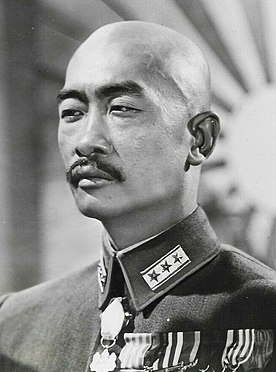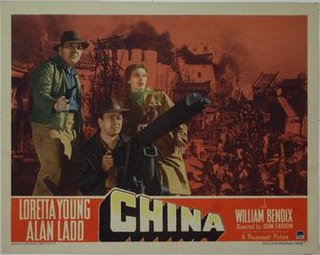Related Research Articles

Keye Luke was a Chinese-born American film and television actor, technical advisor and artist and a founding member of the Screen Actors Guild.

Benson Fong was an American character actor.

Victor Sen Yung, was an American character actor, best known for playing Jimmy Chan in the Charlie Chan films and Hop Sing in the western series Bonanza. He was born in San Francisco, California to Gum Yung Sen and his first wife, both immigrants from China.

Philip Ahn was an American actor and activist of Korean descent. With over 180 film and television credits between 1935 and 1978, he was one of the most recognizable and prolific Asian-American character actors of his time. He is widely regarded as the first Korean American film actor in Hollywood.
H. Bruce "Lucky" Humberstone was a movie actor, a script clerk, an assistant director, working with directors such as King Vidor, Edmund Goulding and Allan Dwan and, ultimately, a director.

Tetsu Komai, also known as Tetsuo Komai, was a Japanese-American actor, known for his minor roles in Hollywood films.

Richard Loo was a third-generation Chinese-American film actor who was one of the most familiar Asian character actors in American films of the 1930s and 1940s. He appeared in more than 120 films between 1931 and 1982.
Eddie Lee was a character actor from the 1930s through the 1950s. Of Asian descent, he played mainly bit parts such as cooks and soldiers. While most of his over 80 roles were uncredited, he did have a few significant roles, such as in 1935's Sunset Range, Panic on the Air (1936), and 1943's The Man From Thunder River.
Lillie Hayward was an American screenwriter whose Hollywood career began during the silent era and continued well into the age of television.
Chester Gan was an American character actor of Chinese descent who worked in Hollywood from the 1930s through the 1950s.

China is a 1943 film directed by John Farrow. It stars Loretta Young and Alan Ladd. David Jones, one of the main characters wearing a fedora, a brown jacket, and khakis, was an inspiration for Indiana Jones.

Historically there has been a population of Chinese Americans in Los Angeles and the Los Angeles Metropolitan Area. As of 2010, there were 393,488 Chinese Americans in Los Angeles County, 4.0% of the county's population, and 66,782 Chinese Americans in the city of Los Angeles.
Milton Quon was an American animator, artist and actor.

James B. Leong was a Chinese-American character actor and filmmaker who had a long career in Hollywood beginning during the silent era.
James Wang was a Chinese actor and casting agent who worked in Hollywood from the 1910s to the 1930s. He is known for discovering actress Anna May Wong.
Allen Jung was an American film and television actor who was active in Hollywood from the 1930s through the 1970s.

Spencer Chan was a Chinese American character actor who had a long career in film and television.
Bruce Wong was a Chinese American character actor, filmmaker, and restaurateur who worked in Hollywood in the 1930s and 1940s.
Frank Tang was a Chinese-American character actor, filmmaker, community leader, and restaurateur who was best-known for directing the 1936 Cantonese-language film Sum Hun.
Edwin Sylvester Luke was a Chinese American character actor who had a career in Hollywood during the 1940s and 1950s. He played Charlie Chan's Number Four Son, Eddie Chan, in the 1945 feature "The Jade Mask", starring Sydney Toler. He was the younger brother of actor Keye Luke. He was one of three Asian Americans - the first cohort - to receive Bachelor's degrees in journalism from the University of Washington in 1936. While a student there, he played on the championship team in the Northwest Chinese Basketball Tournament. Subsequently, he was the first Chinese American member of the International Typographical Union in 1941. In addition to acting, he also worked for The Hollywood Reporter as a typographer, writer, editor and later forged a successful career as a social worker for Los Angeles County. In the 2012 award winning short film "Keye Luke", by Taiwanese-American Director Timothy Tau, Edwin Luke was portrayed by actor Archie Kao.
References
- ↑ California, Jenny Cho and the Chinese Historical Society of Southern (2013). Chinese in Hollywood. Arcadia Publishing. ISBN 9780738599731.
- ↑ "Chinese Actors in Great Demand in Movie Studios". The Pittsburgh Press. 30 Aug 1942. Retrieved 2019-11-10.
- ↑ "Chinese Minister Dies at 85". The Province. 5 Oct 1948. Retrieved 2019-11-10.
- ↑ "Luke Chan Discovers Hollywood No Place for Philosophers". Press and Sun-Bulletin. 29 Jul 1935. Retrieved 2019-11-10.
- ↑ "Chinese Actors Are Busy". The Knoxville News-Sentinel. 27 Dec 1942. Retrieved 2019-11-10.
- ↑ "Chinatown Rises Anew". The Los Angeles Times. 29 May 1938. Retrieved 2019-11-10.
- ↑ "Pirate Junk in China City". The Los Angeles Times. 29 Mar 1939. Retrieved 2019-11-10.
- ↑ Cho, Jenny; California, Chinese Historical Society of Southern (2011). Chinatown and China City in Los Angeles. Arcadia Publishing. ISBN 9780738581651.
- ↑ "Working Mayor". Pittsburgh Sun-Telegraph. 15 Nov 1942. Retrieved 2019-11-10.
- ↑ Gravari-Barbas, Maria; Graburn, Nelson; Staszak, Jean-Francois (2019-08-28). Tourism Fictions, Simulacra and Virtualities. Routledge. ISBN 9781000681178.
- ↑ "'The Purple Heart' Proves Powerful and Dramatic War Film". The Gazette. 1 Apr 1944. Retrieved 2019-11-10.